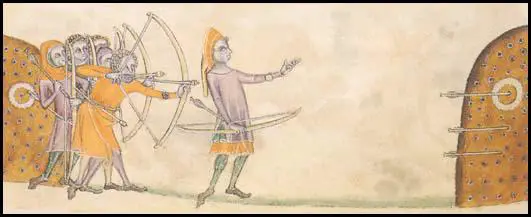Longbow
The most significant weapon in the 14th century was the longbow. Bows and arrows had been used for thousands of years, but the first record of longbows being employed in warfare was in South Wales during the 12th century. William de Braose, an English knight fighting the Welsh in 1188, reported that an arrow had penetrated his chain mail and clothing, passed through his thigh and saddle and finally entered his horse. The English now realised that even heavily mail-clad knights were not safe from the power of the longbow.
This powerful new weapon was soon adopted by the English army. Unlike previous bows, the longbow was longer than the man who used it. Depending on the size of the archer, the longbow could be over 1.85 metres (6 feet) long. Another feature of the longbow was that the string was pulled back to the ear rather than to the front of the chest. This increased both the range and power of the arrow. As well as penetrating armour, the longbow arrow could hit a target 320 metres (350 yards) away. Accurate archers could therefore kill enemy soldiers before they were in a position to attack.
When the longbowmen entered the battlefield, they usually carried several sheaths holding 24 arrows. The arrowheads were made of iron and were about 5 centimetres (2 inches) long. The sheath would contain a variety of arrows of different lengths, weights and feathers. The arrow selected by the archer depended on on the weather conditions and the distance of the intended victim. If longbowmen were captured, their opponents would cut off their thumbs and the first two fingers on the right hand to ensure that they never used a longbow again.

In an attempt to make the English the best longbowmen in the world, a law was passed ordering all men earning less that 100 pence a year to own a longbow. Every village had to arrange for a space to be set aside for men to practise using their longbows.
It was especially important for boys to take up archery at a young age. It was believed that to obtain the necessary rhythm of "laying the body into the bow" the body needed to be young and flexible. It was said that when a young man could hit a squirrel at 100 paces he was ready to join the king's army. In 1314, Edward II became concerned by reports that young people were more interested in playing a new game called football than practising archery. King Edward's answer to this problem was to ban football in England.
It has been claimed that drawing the bowstring back to your cheek bone is equivalent to lifting a 100lb block of concrete with two fingers. To cultivate the special back and shoulder muscles needed it would have been necessary to medieval peasants to have trained from a very young age. This had long-term consequences for the longbowmen. For example, the skeleton of an archer found in the wreck of the Mary Rose showed he had thicker bones in his right arm than his left and a deformed right shoulder from drawing the bow. Other evidence suggests that using such a high-tension weapon often left longbowmen with physical deformities.
